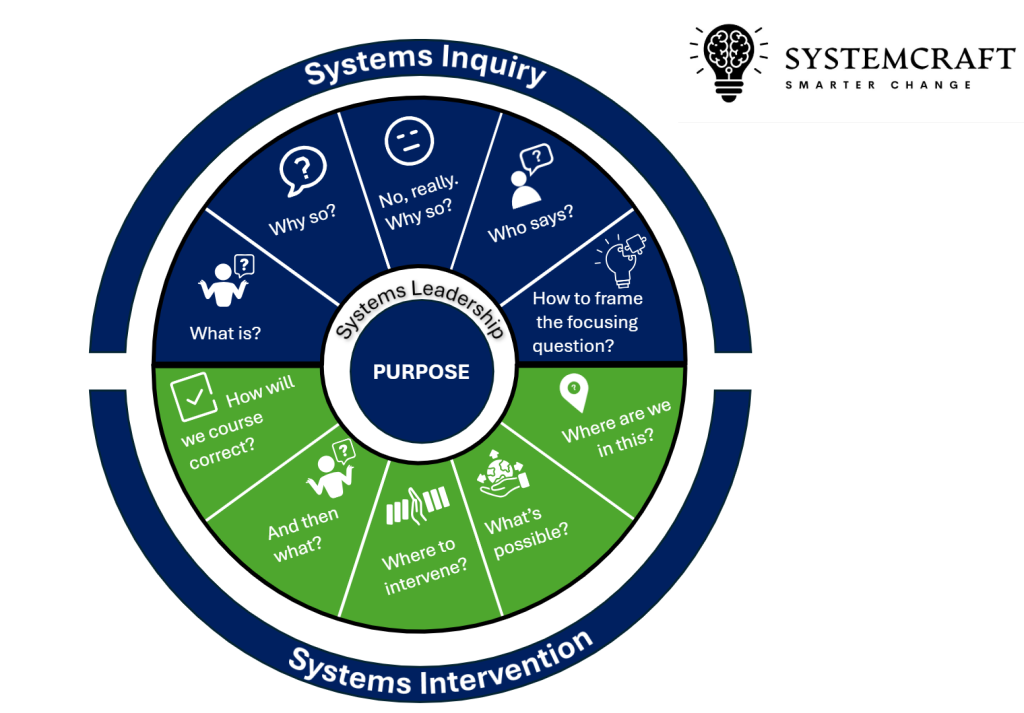19 Summary and Implications for Leaders and Managers. Check your knowledge.

Systems Intervention – summary and Implications for Leaders
The journey of systems intervention begins with a profound understanding of our own place within the systems we seek to change. (Where are we in this?). Like swimmers finally noticing the water around them, we must first acknowledge that we are not mere observers but active participants, carrying our own assumptions and agendas. This humility becomes our greatest asset; not diminishing our power with others to effect change but rather grounding it in authenticity and conscious intention.
Exercises – Questions to Check Learning
Where are we in this?
-
What does the question ‘Where are we in this?’ seek to uncover about our role in a system, and why is reflexivity important in systems change?
-
How does recognising our own payoffs from the status quo contribute to a more honest and effective approach to systems change? Provide an example from an organisational or policy context.
-
Why is positionality important in systems thinking, and how can tools like perspective-taking and stakeholder engagement help uncover biases in how we understand and propose changes to a system?
What’s possible?
-
Why is it important to distinguish between plausibility and feasibility when assessing potential system interventions, and how do these concepts shape strategic decision-making? Provide an example from a complex policy or organisational context.
- According to John Kingdon’s concept of ‘windows of opportunity’ and Isaiah Berlin’s notion of political judgment, why is timing crucial in system change? How can leaders assess whether the moment is right for intervention?
Where to intervene?
-
How does Donella Meadows’ concept of leverage points help us assess the effectiveness of system interventions? Using the Robodebt example, explain why focusing on low-impact interventions (such as automation) can lead to failure.
-
What is solutionism, and why does it pose a risk in systems interventions? How did the Robodebt scheme exemplify this tendency, and what could have been done differently to avoid its failures?
-
Why are paradigms and the power to transcend paradigms considered the most powerful leverage points for systemic change? Provide an example of a paradigm shift that could have led to a more just and effective welfare policy in place of Robodebt.
And then what?
-
Why is it important for leaders to consider second- and third-order effects when designing system interventions? Use the Queensland Health payroll implementation as an example to illustrate how failing to ask ‘And then what?’ led to unintended consequences.
-
How do systems archetypes, such as ‘Fixes That Fail’ and ‘Shifting the Burden,’ help us anticipate the long-term effects of interventions? Provide an example of an intervention where a short-term fix created new systemic challenges.
-
Why is reflexivity crucial in systems interventions, and how can leaders ensure they are not reinforcing existing power dynamics or systemic inequities when intervening?
How will we course correct?
-
How does the Viable System Model (VSM) help organisations remain adaptive and resilient? Using Robodebt as an example, explain how failures in System 3 (Operational Oversight), System 4 (External Adaptation), and System 5 (Ethical and Strategic Governance) contributed to systemic breakdown.
-
What role do feedback loops play in organisational effectiveness, and what are the risks when they are missing or suppressed? Provide an example from a public or private sector failure where the absence of corrective feedback led to negative consequences.
References
- Joyner, K. (2025) Systems thinking for leaders. A practical guide to engaging with complex problems. Queensland University of Technology. https://qut.pressbooks.pub/systemcraft-systems-thinking/

